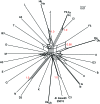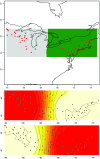Evolution and distribution of the ospC Gene, a transferable serotype determinant of Borrelia burgdorferi
- PMID: 20877579
- PMCID: PMC2945197
- DOI: 10.1128/mBio.00153-10
Evolution and distribution of the ospC Gene, a transferable serotype determinant of Borrelia burgdorferi
Abstract
Borrelia burgdorferi, an emerging bacterial pathogen, is maintained in nature by transmission from one vertebrate host to another by ticks. One of the few antigens against which mammals develop protective immunity is the highly polymorphic OspC protein, encoded by the ospC gene on the cp26 plasmid. Intragenic recombination among ospC genes is known, but the extent to which recombination extended beyond the ospC locus itself is undefined. We accessed and supplemented collections of DNA sequences of ospC and other loci from ticks in three U.S. regions (the Northeast, the Midwest, and northern California); a total of 839 ospC sequences were analyzed. Three overlapping but distinct populations of B. burgdorferi corresponded to the geographic regions. In addition, we sequenced 99 ospC flanking sequences from different lineages and compared the complete cp26 sequences of 11 strains as well as the cp26 bbb02 loci of 56 samples. Besides recombinations with traces limited to the ospC gene itself, there was evidence of lateral gene transfers that involved (i) part of the ospC gene and one of the two flanks or (ii) the entire ospC gene and different lengths of both flanks. Lateral gene transfers resulted in different linkages between the ospC gene and loci of the chromosome or other plasmids. By acquisition of the complete part or a large part of a novel ospC gene, an otherwise adapted strain would assume a new serotypic identity, thereby being comparatively fitter in an area with a high prevalence of immunity to existing OspC types.
Figures






References
-
- Steere A. C., Coburn J., Glickstein L. 2005. Lyme borreliosis, p. 176–206. In Goodman J. L., Dennis D. T., Sonenshine D. E., Tick-borne diseases of humans. ASM Press, Washington, DC.
-
- Bunikis J., Tsao J., Luke C. J., Luna M. G., Fish D., Barbour A. G. 2004. Borrelia burgdorferi infection in a natural population of Peromyscus leucopus mice: a longitudinal study in an area where Lyme borreliosis is highly endemic. J. Infect. Dis. 189:1515–1523 - PubMed
-
- Seinost G., Golde W. T., Berger B. W., Dunn J. J., Qiu D., Dunkin D. S., Dykhuizen D. E., Luft B. J., Dattwyler R. J. 1999. Infection with multiple strains of Borrelia burgdorferi sensu stricto in patients with Lyme disease. Arch. Dermatol. 135:1329–1333 - PubMed
-
- Bunikis J., Garpmo U., Tsao J., Berglund J., Fish D., Barbour A. G. 2004. Sequence typing reveals extensive strain diversity of the Lyme borreliosis agents Borrelia burgdorferi in North America and Borrelia afzelii in Europe. Microbiology 150:1741–1755 - PubMed
-
- Girard Y. A., Travinsky B., Schotthoefer A., Federova N., Eisen R. J., Eisen L., Barbour A. G., Lane R. S. 2009. Population structure of the Lyme disease spirochete Borrelia burgdorferi in the western black-legged tick (Ixodes pacificus) in Northern California. Appl. Environ. Microbiol. 75:7243–7252 - PMC - PubMed
Publication types
MeSH terms
Substances
Associated data
- Actions
- Actions
Grants and funding
LinkOut - more resources
Full Text Sources
Molecular Biology Databases
